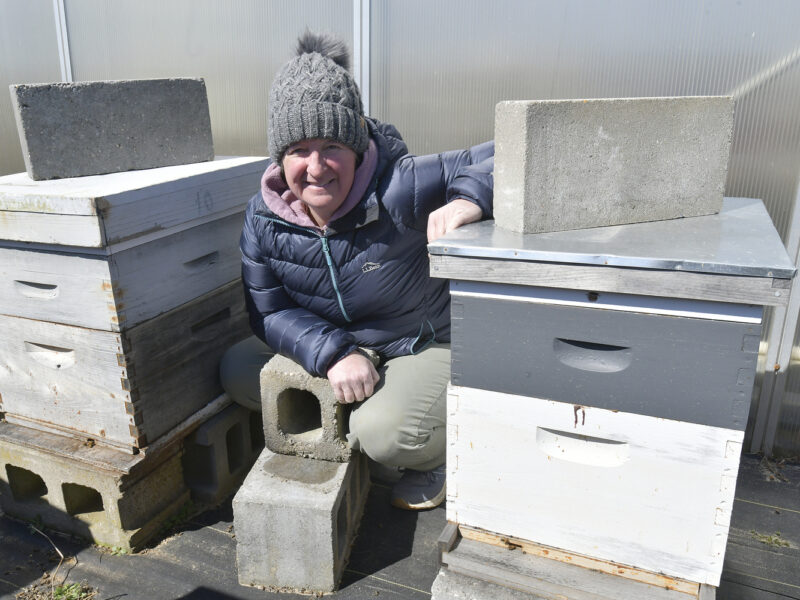

This is the second of a two-part series related to the Birds and Bees Protection Act.
Jennifer Dupree, owner of the Milk Pail and nearly 70 acres of farmland in Bridgehampton, is a big fan of the Birds and Bees Protection Act, signed into law by Governor Kathy Hochul late last year.
“Ninety-five percent of the farmers out here are very conscious of the land, the groundwater, of using sustainable practices and not polluting,” Dupree says.
One complaint some have about the bill is that it doesn’t ban neonics completely and quickly. But State Assemblyman Fred Thiele, a member of the state’s environmental and conservation committee and one of the act’s co-sponsors, said that, like most bills, this one went through several iterations before getting enough votes to pass into law.
“I wouldn’t say they weakened the bill considerably,” he said. “It delays some of the implementation depending on the particular neonics you’re talking about,” to give farmers time to adopt alternative methods. Essentially, the bill will ban the use of neonics as of January 1, 2027, in most instances.
Dupree, a beekeeper as well as farmer, said she’s very conscious of the balance between keeping both her farm and her bees healthy, but also understands the gradual implementation of the ban. “The agricultural community needs time to adjust. If you just ban something suddenly, we’re in trouble — what are we going to use to control this insect?”
“As a grower, I understand that products are going to come and go, and there’s likely a good reason if they’re going,” said Dupree, adding that over the years she has worked with numerous organizations, including the New York Department of Environmental Conservation, the Suffolk County Health Department and Cornell Cooperative Extension.
“In 2016, I allowed them to put four test wells on my farm,” she said. “They started about halfway down where the U-Pick section is and went all the way down by the bay. Then I said to them, ‘Hold on, can you put one in up by my house so you can catch what’s coming from the housing development across the street and make sure I don’t get blamed for it?’”
As it turned out, she said, “The first thing they found — not at harmful levels, but noticeable — was DEET, which is the stuff you spray for ticks. So that’s in the wash water, coming from the houses across the street.”
“As farmers, we get blamed for a lot,” she added, “but you have to look at how much agriculture is out here, compared to the number of lawns and trees being sprayed. We’re not the ones using a ton of fertilizer — we totally understand that all of this is going into our groundwater.”
Dupree said she practices IPM, or integrated pest management, which involves figuring out exactly which insects are present, and where they are. “Cornell comes in and does trapping. Depending on what insect I have, I might not have to treat the whole orchard. I also use pheromone ties — the guys hang thousands of them all over the orchard.
“They last the whole season and are effective for oriental fruit moths, coddling moths and lesser peach tree borers. The ties release a pheromone, so it’s like the orchard being covered in a scent cloud. So you have the mom and dad insect, and we just messed up their perfume so they can’t find each other and mate. It protects the orchard all season long and it’s a pheromone — no toxic chemicals.”
Dupree said that when she first got out of college, she was all-in on organics, but realized that in practice, no solution is perfect. “The amount of sulfur I had to use to control brown rot was unbelievable, so here I am as a grower and I’m trying to use organic, but I’m dumping pounds and pounds of sulfur into the tank, and it’s coming up as a dust cloud — and I’m asking myself, how is that safer? Instead, I could use a synthetic product which was tested in a science lab, and I’m using ounces per acre, so you’re talking about basically a little grain of sugar in your cup of coffee.
“There’s a give-and-take with organic,” she continued. “When the marketers caught on to the appeal of ‘organic’ — that people thought it meant no chemical spraying — they never corrected them. And it just took off like wildfire, which is too bad, because people were educated wrongly about it. That’s why we promote buying local — knowing where your food comes from. I have no problem telling you exactly what I use on my crops.”
Part of the problem facing farmers, she added, is that the public has come to expect produce without a single blemish. “If the general public wasn’t so hung up on having a perfect-looking apple or a perfect zucchini, we could let more things slide,” said Dupree.
In addition to things like pheromone ties, Dupree uses cover crops like oats and peas, which she grows, then mows down to feed nitrogen back into the soil. “In the fall I plant rye and vetch. The vetch is a legume that overwinters, and the rye makes a straw mulch that I can grow next season’s pumpkins on, and it builds up the organic matter in the soil. Farming this way, I’ve reduced my fertilizer use by three-quarters, and the fertilizer I do use is slow release, so half is released at planting and the other half is released gradually as the soil temperature warms up.
Another technique with great potential is the use of UV lights. Dupree explained that a researcher with Cornell Cooperative recently got a grant to treat fruit trees with ultraviolet lights at night. The machine, she said, goes up and over and around the apple trees, adding that UV treatment holds potential for treating a lot of diseases that impact the crops, including fire blight and apple scab.
“So there’s all this new technology where it might not be organic,” she said, “but it’s great.”
Tish Rehill, owner of the landscape company Gardeneering, has worked for years to educate homeowners about healthier yard management. “I consider educating clients to be part of my job,” she said. “I will talk to them about their lawn, about how we can keep it as healthy as possible without toxic chemicals. I’ve convinced them that clover is good for the lawn — it puts nitrogen back into the soil, which nourishes the grass. You can also use things like milky spore to control grubs, and in the spring we use neem and other oils to control things like scale. The oils are not biologically active, so they’re not putting chemicals into the environment, but they suffocate the cottony scale.”
Rehill also switched from gas-powered to electric blowers long before local governments began mandating the change. “As soon as I found out what my guys were inhaling, I switched to electric. Using a gas blower is like putting your mouth on a Dodge Ram tailpipe, and so many lawn guys were coming down with cancer and other serious health issues.”
Rehill, who’s never used neonics, is in favor of the new Birds and Bees Protection Act, though she wishes it went further — banning all neonics more quickly. “I tell my clients, you have children running on this lawn. They’re barefoot, they’re rolling around on it. You have dogs running round on this lawn and eating the grass. You can maintain a healthy lawn without using dangerous products on it.”
“We make a compost tea from mulch, and we use a lot of that during the summer months,” she said. “It works wonders on lawns, and those applications mean we can use a lot less fertilizer and insecticides.
“There’s a direct correlation between the use of neonics and the decline of birds and bees,” Rehill added. “Just speaking for myself, I see so many more lightning bugs on my property since I stopped using so many chemicals.”
 More Posts from Lisa Daffy
More Posts from Lisa Daffy